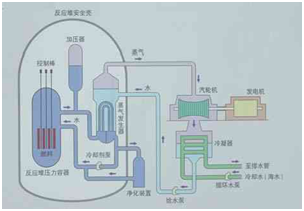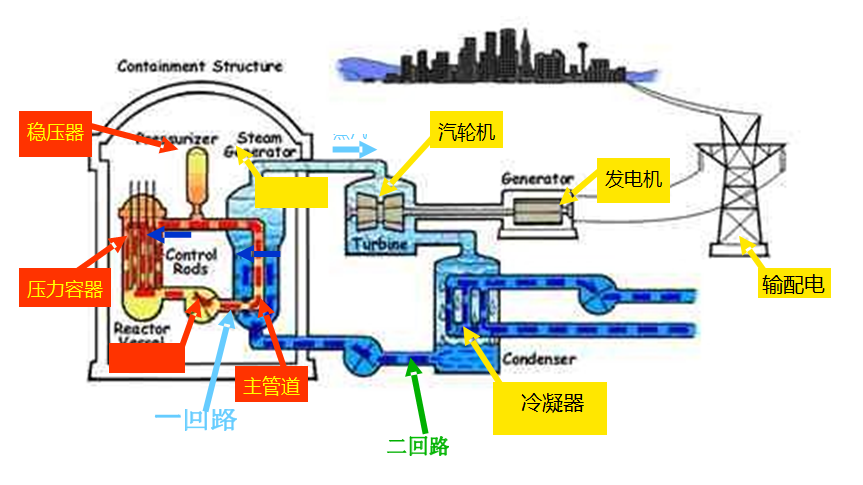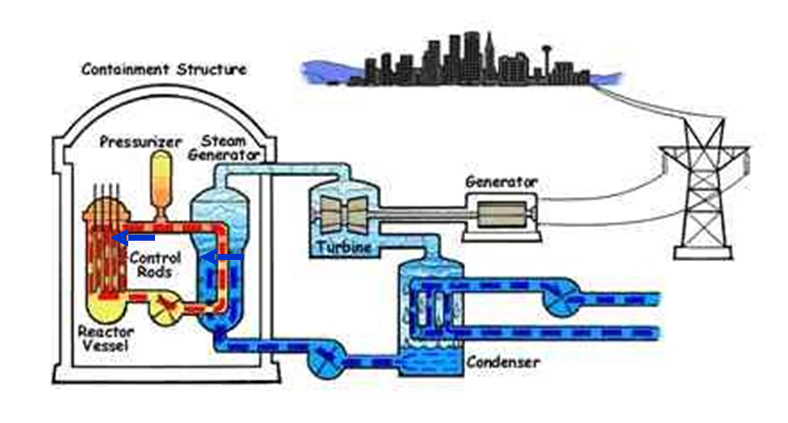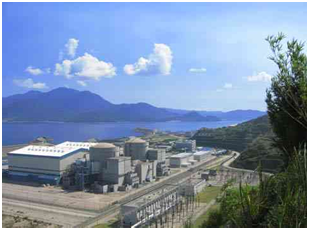1. 發電原理
1. Philosophy of electricity producing
核燃料在核反應堆堆芯中進行鏈式反應,產生熱能,同時燃料中的反應碎片的裂變速度變慢并消散其動能。這些熱能必須被有效地,并且以相同速率帶出堆芯,以防止堆芯過熱,同時也把熱能傳送出堆芯。在堆芯外,熱能被轉變成另一種便于進一步利用的能源形式。一種流體就可以達到這個目的。在輕水堆中,輕水用作慢化劑和冷卻劑。當冷卻劑流經核燃料元件時,帶走其產生的熱量,以高溫高壓的形式儲存在冷卻劑里。
The nuclear chain reaction in the reactor core produces energy in the form of heat as the fission fragments slow down and dissipate their kinetic energy in the fuel. This heat must be removed efficiently and at the same rate it is being generated in order to prevent overheating of the core and to transport the energy outside the core where it can be converted to a convenient form for further utilization. A fluid is used for the purpose. In the light-water reactor case, water is used as both moderator and coolant. The energy transferred to the coolant, as it flows past the fuel elements, is stored in it in the form of temperature and pressure.
儲存在冷卻劑中的熱量通過蒸汽汽輪機進一步轉變成動能。最后通過蒸汽汽輪機把動能轉換成電能并以這種能量形式通過電網傳送給用戶和傳輸系統。
The energy stored in the fluid is further converted into kinetic energy through a device called steam turbine. Finally, the kinetic energy is converted into electric power via steam turbine as the final energy form to be distributed to the consumers through the power grid and distribution system.
通過兩個分開的但由蒸汽發生器相連的回路把熱能從堆芯傳送到汽輪機。蒸汽發生器是大型壓水堆的構件,熱量從主回路通過蒸汽發生器傳送到第二回路,同時產生蒸汽。
The transport of thermal energy from the core to the turbine takes place through tow separated but interlocking loops, connected through steam generators. Steam generators are large PWR components in which heat form the primary circuit is transferred to the secondary with the production of steam.
2.壓水堆的主要系統和構件
2. PWR Primary system and components
壓水堆中的主回路一直保持在一個高壓的狀態下,壓水堆以此而得名。這個壓力通常是2200pis左右(大約15Mpa), 所以在反應堆容器中溫度可以達到最高值。在這么大的壓力下,水的沸點是343度,大于主回路中允許的水的最高溫度332度。
The name of the PWR derives from that the primary circuit is kept at a very high pressure, typically around 2200 psi (equivalent to about 15 Mpa), such that at the maximum prevailing temperature in the boiling can occur. At 2200 psi, the boiling temperature of water is about 343℃, well above the maximum temperature of 332℃ allowed in the primary water.
壓水堆核電站的基本環路和構件由以下組成:
The basic circuits and components of a PWR plant include mainly:
- 包含反應堆堆芯的反應堆壓力容器
- The reactor pressure vessel, which contains the core.
- 主要的冷卻環路。這些環路構成了主要的壓力裝置.其中包括高壓下的水循環環路,用于帶走堆芯中裂變產生的熱量.
- The primary coolant circuit. These constitute the primary pressure boundary which contains water circulating at high pressure to remove fission- produced heat from the core.
- 一個熱交換器或者蒸汽發生器。熱量經此被傳送到第二回路。還包括一個生成蒸汽的水循環系統。
- A heat exchanger or steam generator, in which heat in transferred to a secondary loop, also containing circulating water, where steam is generated.
- 能量轉換系統,把蒸汽轉換成電能
- The energy conversion system where steam is used to make electricity.
壓水堆核電站最重要的構件有:反應堆壓力容器和堆內構件,燃料束,控制棒和驅動裝置,主冷卻劑泵,穩壓器,蒸汽發生器,汽輪機,冷凝器等。
The most important components of a PWR plant are reactor vessel and internals, fuel bundles, control rods and drive mechanism, primary coolant pump, pressurizer, steam generator, turbine, condenser, etc.
3. 壓水堆容器的設計方案
3. PWR Containment Design
大多數的安全殼廠房是垂直的圓柱體型預應力后張拉鋼筋砼結構,底部是一個扁平基礎底板,筒體被一層鋼襯里圍著,上面是一個淺的穹頂。
Most of the Containment buildings are vertical cylindrical prestressed post-tensioned structures with a steel liner covered with a hemispherical or a shallow domed roof and with a flat foundation slab.
�




